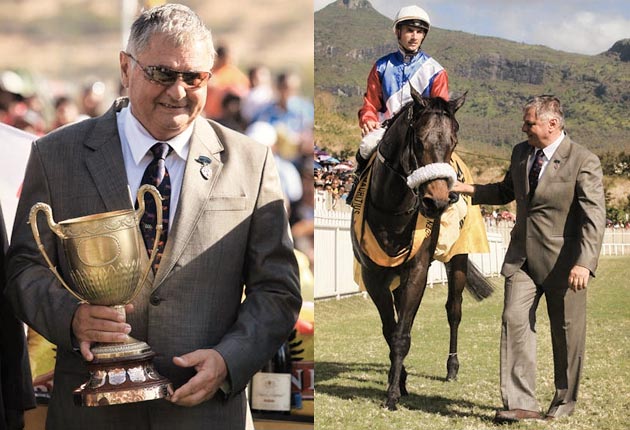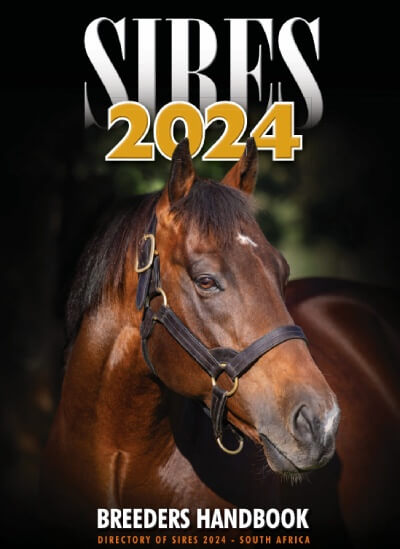
Ricky Maingard and Ice Axe, Gr1 Phoenix Maiden Cup winner
THE PHOENIX MAIDEN CUP Gr1
Champ de Mars, Turf, 2400m – 2 September 2012
There’s no blue-blooded South African racing fan who doesn’t remember Wolf Power, and the fact that Ricky Maingard, an engineer by profession and a one-time motoring executive with Peugeot by trade, was the man that fashioned him into one of the world’s most formidable milers. On Sunday, at Champ de Mars racecourse in the heart of the capital city of Mauritius, Port Louis, Maingard’s considerable skills as a racehorse conditioner were highlighted once again with the victory of Ice Axe in the islands’ greatest horserace, the Maiden Cup (Gr.1). But before we describe Ice Axe’s famous victory in more detail, it’s worth dwelling for a moment on Maingard’s beginnings as a racehorse trainer.
At that time, he was living in a little-known Midrand suburb called Glen Furness, and living as he did some distance from a racecourse, without the ample means to transport his horses daily to and from a training track, Maingard persuaded his neighbours into allowing him to work his horses across their seven acre plot of land. We know this, because one of his neighbours was Pat Goss, one of the co-founders of the Summerhill Stud we know today. It wasn’t long before he made his mark, and he did so in great style with a succession of the country’s top fillies. Run For Lily was a champion, Rhapsody’s Footstep and Fairy Ring were not far behind, and then came Dancer’s Choice, who ran Olympic Duel to a length in the Fillies Guineas. It wasn’t long before the country’s top owners were clamouring for Maingard’s services, and he was quickly in a position to buy himself Wolf Power, the best juvenile prospect in the land. Maingard was an all-rounder though, capable of training them short and long, and his tally of winners included several victories in the country’s number one sprint at the time, The Gilbey’s, The Rothman’s July and the Gold Cup, from 1200m to 3200m.
That age has not wearied him, was evident on Sunday when Ice Axe proved emphatically that he was this year’s Mauritian Horse Of The Year. Though Ice Axe was unbeaten to date, including two victories over the country’s top horse, Il Saggiatore, it was widely expected (and his odds-on status in the betting endorsed it), that with a 3kg pull at the weights and a change of pilot, Il Saggiatore would prevail. Those of you that read our column last week, might’ve been persuaded to take the odds on Ice Axe, and you would have been an even wealthier punter by Monday morning. Despite the presence in the field at the racecourse founded in 1812 by Sir Robert Farquhar, of three candidates from the powerful Gujadhur stable, Ice Axe was always travelling like a winner. There was a moment though, with about 800m to go, when it looked like he might be out-manoeuvred, as the three Gujadhur entries surrounded him, one immediately in front of him, one just to his outside and the favourite creeping up behind that one, while Ice Axe had the rail on his inside to prevent him from going anywhere unless something fluffed its lines. The tiniest of gaps opened as they turned for home, by which time Il Saggiatore had poached a precious lead, and seemed set for home. Ice Axe rallied gamely, and finding the greater acceleration, he raced away from the son of Galileo, who himself had just celebrated a world-record ten stakes winners in a week.
This victory provides the winner’s Northern Guest-dam with her second winner at the highest level, his half-sister Icy Air having swept everything before her in the 3-year-old division of her year. His granddam, a daughter of the great French classic sire, Luthier, was a purchase at the Nelson Bunker Hunt dispersal sale in 1988, and she has since given us, through her daughters, not only these two accomplished performers, but also the champion stayer, Amphitheathre. The Hunts were famed for their monopolisation of the silver trade, but following an attempt to corner that market, Bunker Hunt was forced to disperse his enormous thoroughbred empire after five years as the Eclipse Award Breeder of America.
Before we leave the Champ de Mars finally, it’s worth recalling a couple of interesting oddities about its history. At 200 years this year, it is the oldest racing club in the Southern Hemisphere, and the third in the world. Sir Robert Farquhar was the inaugural governor of the island after its capture by Britain from France in 1810, and the course was used as a post-war means of securing the “esteem and collaboration of the local French population”, by providing them with the entertainment of horseracing. A street runs through the course between the grandstand and the racetrack, which is in normal everyday use, except for racedays, of course. The street is named for the Duke Of York, and the raceday experience has echoes of a Greyville meeting of thirty years ago. There are more than forty bookmakers on course, and their designated area across the way from the main stand is a beehive of activity.
Despite the humid tropical climate, entry into the VIP areas is “tight” and suits are the prescribed form of dress. You daren’t remove your jacket in the Steward’s Lounge, for fear of sanction. The parade ring resembles a medieval theatre, surrounded as it is by a public stand on one side, and by four levels of private boxes on two sides. It has the feel of a Mediterranean courtyard, with flowering geraniums hanging from flower boxes on all sides. The right-handed track is notoriously tight, with a circumference of only 1298m (which means the Maiden Cup almost completes two circuits), and a straight of only 225m. That means you have to have an ability to navigate the sharp turns, as well as finding a scorching turn of foot.
At Sunday’s meeting, there would have been close to 40,000 in attendance, with the infield jam-packed with spectators using the tarred surface of the Duke Of York Avenue as a jumping castle, in their attempts at seeing over the heads of those in front of them, while others enshroud the tops of the surrounding hills looking down on the course.
For more information, please visit :www.mauritiusturfclub.com extract from Summerhill blog








